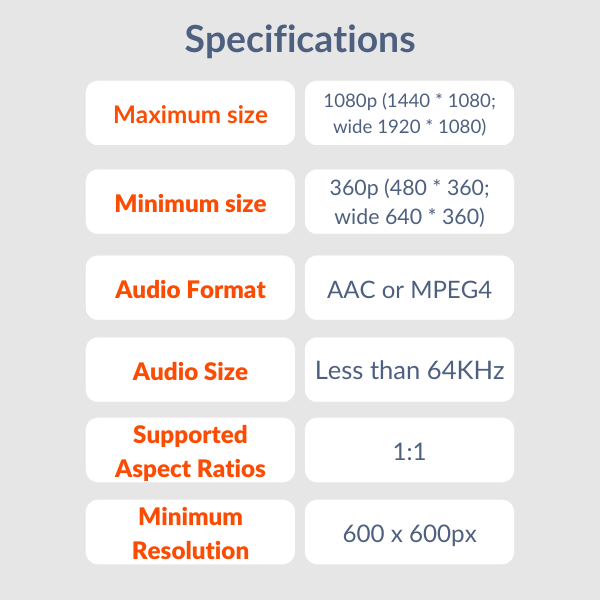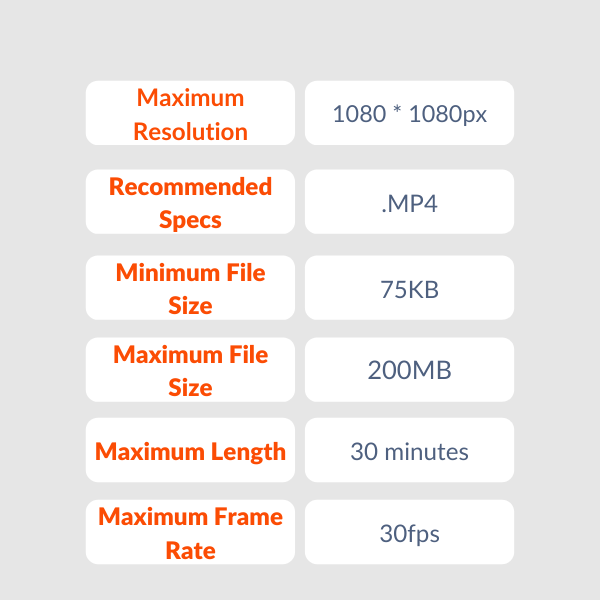Nikhitha
Blogs
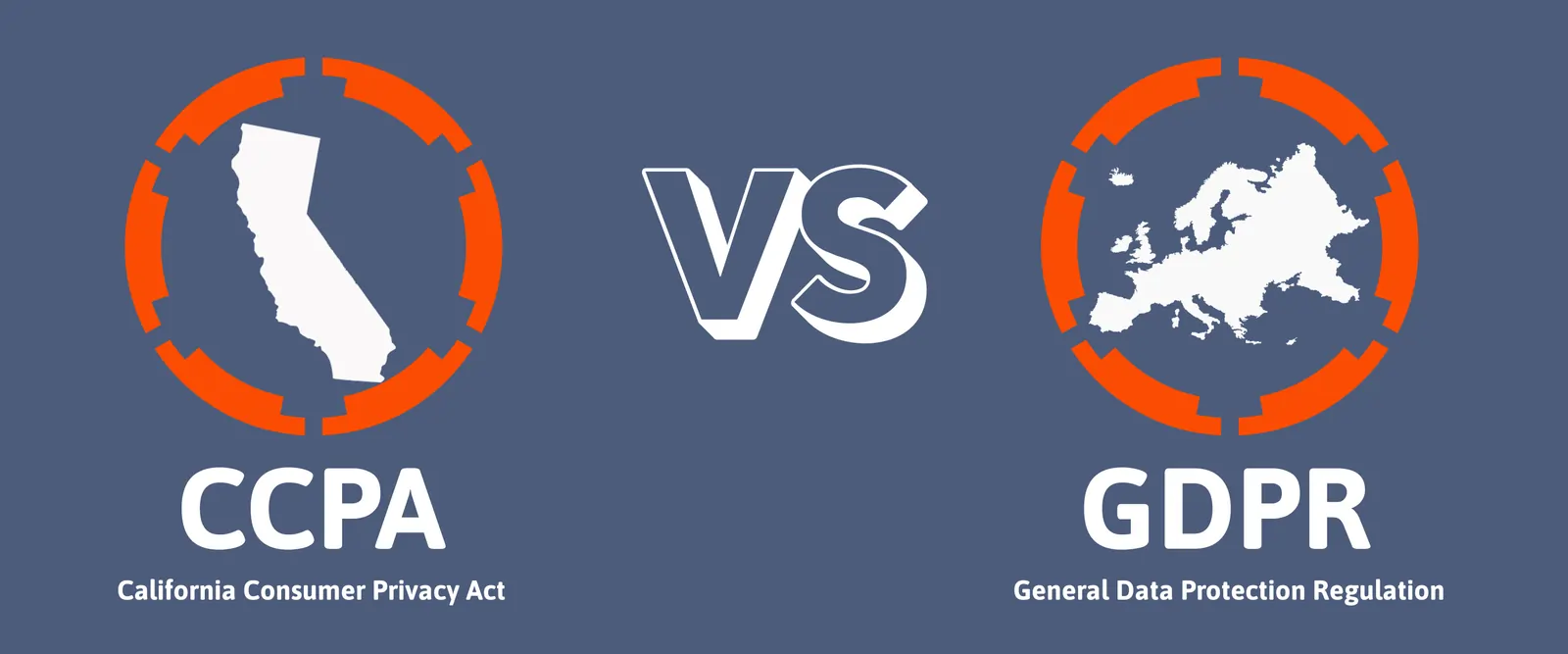
CCPA Vs GDPR: What’s The Difference?
An infographic to explain the similarities and differences of the California Consumer Privacy Act (CCPA) and the General Data Protection Regulation (GDPR).

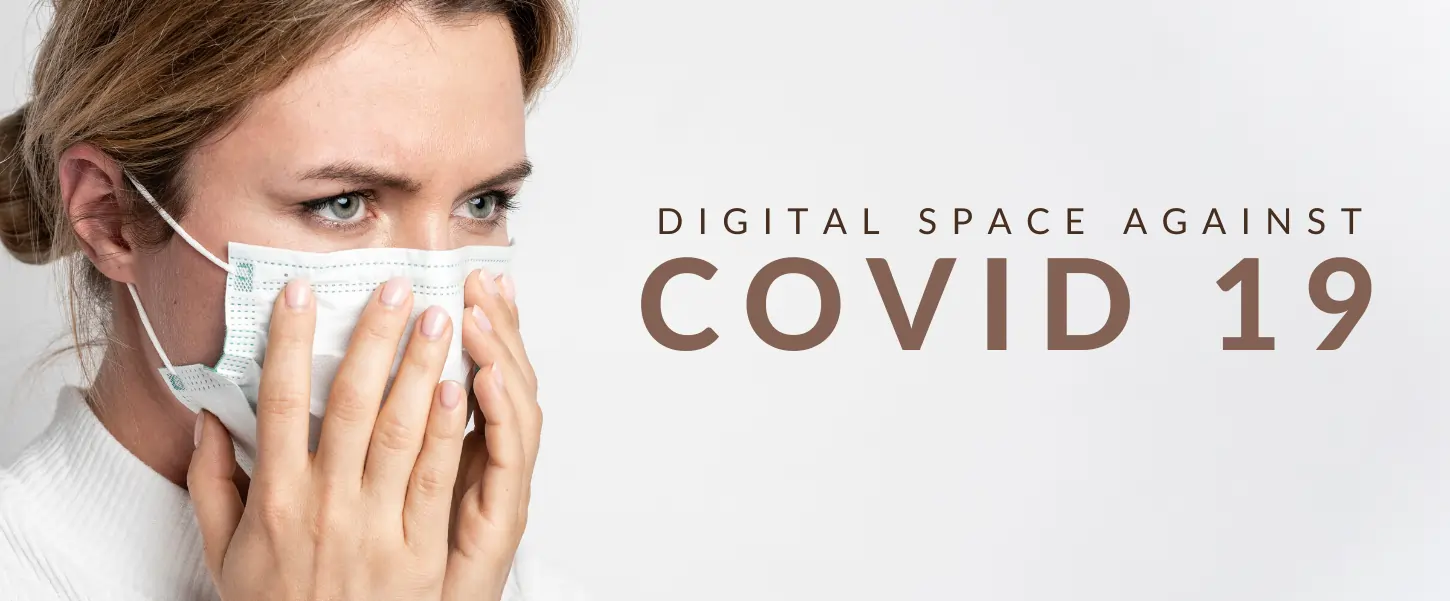
How Cyberspace Is Joining Hands To Fight Against COVID-19?
The spread of COVID-19, the novel strain of coronavirus, has officially reached pandemic proportions. Doctors, nurses, carers and paramedics around the world are facing an unusual workload in overstretched health facilities. They are working in a stressful and frightening work environment. Communication is everything in this health emergency. Without public health information at our fingertips, many would-be dangerously under-informed about the scale and severity of the issue.
Over the past few weeks, we’ve been seeing that lockdown laws are being imposed on various parts of the world and social distancing is being promoted. The Internet & Internet Related Services are enhancing lives by acting as a vital public service and connecting people in creative and positive ways. It is both a lifeline and a crucial force in helping to control the spread of the virus, providing important public health information and helping us live virtually when meeting physically threatens human lives.
However, at present, we’re not only fighting an epidemic but also an infodemic. Fake news, medical misinformation and conspiracy theories spread faster and more easily than the virus, and is just as dangerous. To control this, the internet’s largest social network companies have issued a joint statement on the coronavirus COVID-19 outbreak. They have promised to fight the fraud and curb misinformation shared on their platforms. Facebook, Google, YouTube, LinkedIn, Instagram, Twitter, etc co-signed the statement. These platforms are also providing free access to coronavirus news.
In this blog, we are discussing the major steps social media platforms have taken to get critical information to their billions of users.
Google has launched a website, developed in partnership with the governing bodies of respective governments, to provide information and resources about the pandemic. It includes prevention tips, a map of areas affected by the outbreak and links to local health agencies, which are available in different languages.
For people specifically looking for information about symptoms, prevention or treatments, they have included a COVID-19 knowledge panel.
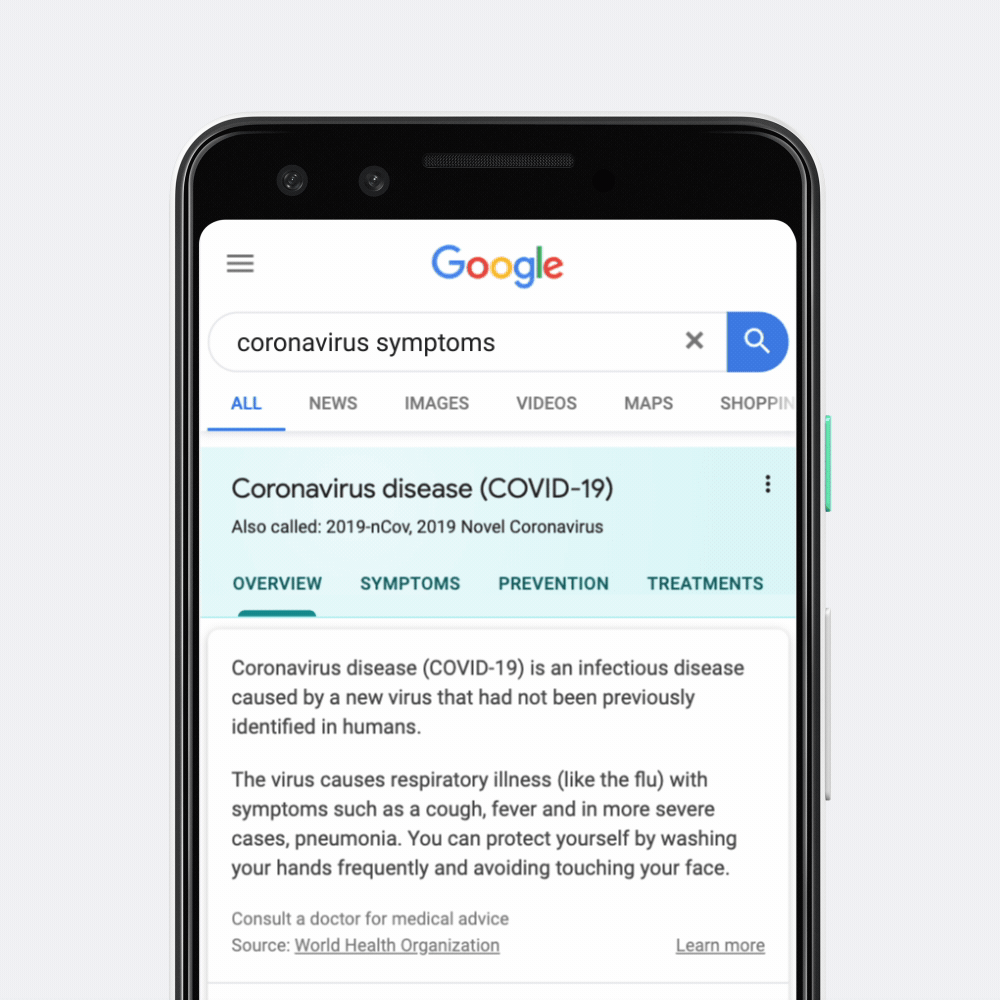
Google searches related to coronavirus show an “SOS Alert” banner, followed by news from mainstream outlets and information from recognized health organizations and governments.
As part of the measures taken to give out reliable information during this pandemic period, Google has disabled app searches for ‘coronavirus’ on Google Play Store, their mobile app store. They are also removing misleading information and fake reviews about healthcare locations from Google Maps, using a combination of automated and manual review systems.
In addition to that, Google My Business will not be publishing any new reviews, review replies, or new Q&A until further notice whereas existing reviews, review replies, and Q&A will be visible. This is because they want to make sure that the information provided is valid and from trusted sources. Their support team will prioritize reviewing new listings, claims, and verifications for critical health-related businesses only. Since Google is prioritizing critical services, other types of businesses can expect a delay in the publication of new listings, claims, and verifications.
As the world’s largest social media platform, Facebook is running a ‘Coronavirus Information Center’ for better information sharing with their audience. It is an initiative to help people find information and tips, on top of existing measures introduced to beat scams, ads and other sources of misinformation. When users search for ‘coronavirus’, Facebook shows a banner directing them to the WHO or their national health organization. Ads that attempt to exploit the outbreak by selling ‘miracle cures’ or medical face masks at grossly raised prices are banned.
Facebook has created a Messenger Coronavirus Community Hub with tips and resources to help users recognize scams and misinformation and prevent their spread. As people spend more time online due to social distancing measures, Facebook also launched its digital literacy program named “Get Digital” to help young people develop the necessary skills to safely navigate the internet.
Youtube
YouTube has also promised to promote verified, informative videos of coronavirus information on its homepage. YouTube has also promised to promote verified, informative videos of coronavirus information on its homepage.
[su_youtube_advanced url=”https://www.youtube.com/embed/9cfYC4YLsu4″ autoplay=”yes” mute=”yes” loop=”yes” rel=”no”]
YouTube has introduced information panels from the WHO or to their national health organizations which appear when you search for coronavirus. It is also providing governments and NGOs with free ad space and removing harmful medical misinformation videos. Since most of the people are working from home or either use watching videos for spending their time due to quarantine they have cut down the video quality from HD (1080p & 720p) to SD (480p) to reduce traffic on mobile and broadband networks.
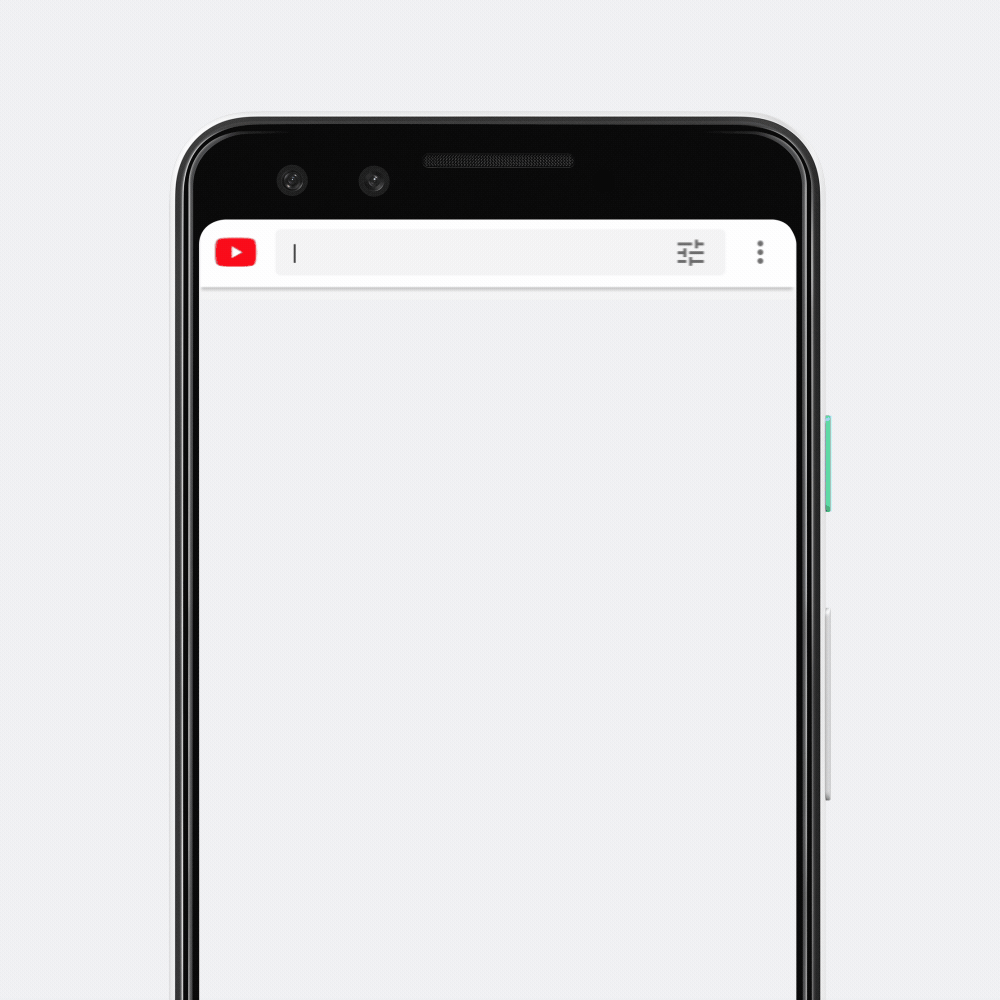
Similar to Facebook and YouTube, Twitter directs users to national health organizations when they search for coronavirus-related terms. It has also pledged to ban ads that exploit the outbreak. Twitter updated its safety policy to announce that it would ban tweets that “could place people at a higher risk of transmitting COVID-19”. The new policy bans tweets denying official guidance, including encouraging “fake or ineffective treatments, preventions, and diagnostic techniques” and misleading posts that pretend to be from authorities or experts. However, they won’t be able to take down every tweet containing misleading coronavirus information. Twitter has promised to provide NGOs with advertising credits to support public health campaigns.
Rumors and lies are reportedly running wild in WhatsApp group chats, including through the medium of voice notes. However, due to the Facebook-owned messaging platform’s heavily encrypted structure, these communications can’t be monitored or moderated. But the Facebook messaging service launched the WhatsApp Coronavirus Information Hub, working with the WHO, UNICEF and UNDP to keep its global users informed about the pandemic and thus they can limit the spread of rumors.
WHO launched a chatbot on WhatsApp to help users get accurate information. The service will be available in Arabic, Chinese, French, Russian and Spanish. As well as launching a WHO chatbot, WhatsApp has expanded its collaboration with governments to provide information services on the coronavirus, with the UK and India teaming up with the messaging app to provide information services.
Similar to Facebook, Instagram is also blocking and restricting coronavirus hashtags by rerouting users to public health organizations. A search for #coronavirus shows a pop-up redirecting users to the Centers for Disease Control and Prevention website. Facebook launched a new system, “proactive sweeps” that will remove other hashtags spreading misinformation on Instagram. Instagram is banning ads that exploit the crisis. It has also banned users from searching for filters with COVID-19 themes unless they were made in partnership with recognized health organizations.
Besides this, the platform has added educational resources in Instagram Search, as well as stickers promoting accurate information. Instagram has also expanded its donation sticker to more countries to help connect users with nonprofits. They have created a “Stay Home” shared story encouraging those practicing social distancing to virtually connect.
In this extreme case of COVID-19 interventionism, the Chinese social media and the messaging app has been widely censoring coronavirus-related content, including critical and neutral information. With broad censorship rules that block messages containing hundreds of coronavirus keywords and keyword combinations.
TikTok
The most popular video-sharing app across the world, Tik-Tok has guidelines that prohibit content that could be harmful. Like all other social media platforms, when users search for ‘coronavirus’ they are presented with a WHO banner.
In the midst of a public health crisis, not only health workers but all major social media platforms have become an important player during the coronavirus outbreak. Social media platforms are finding ways to offer authoritative information to help people. The most effective way to fight this spread is for everyone to practice social distancing while being virtually connected
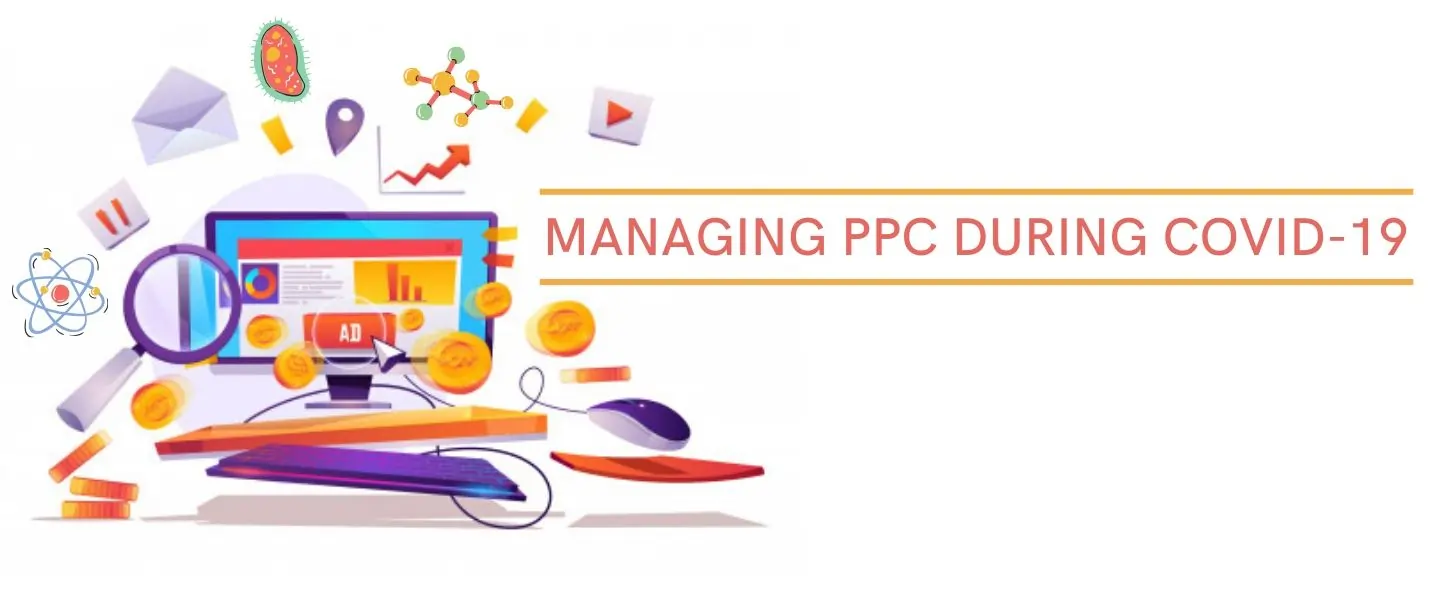
Tips to Manage PPC Campaigns During the Covid19 Pandemic
The majority of commercial shops are in the state of shutting down across the country due to the spread of the Novel Coronavirus or Covid19. PPC advertising and digital marketing also changed overnight due to this pandemic. This situation will require advertisers to be brave, creative, and patient. Here, we are discussing some tips to help you better manage your campaigns during this crucial time.
Review your Marketing Spend
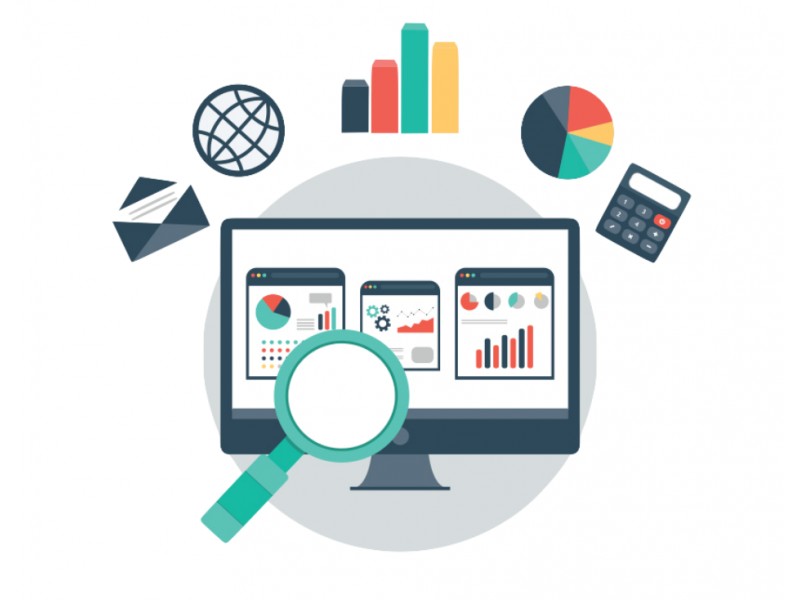
This is the best time to re-evaluate your marketing budgets. Review budget vs spend to find the unused funds and apply that fund to the campaigns that need it most. The most important metric for evaluating the success of the campaign should be the return on investment (ROI) or return on ad spend (ROAS). Consider shifting budget only to the relevant products or services during this emergency time. This helps the campaign to provide the maximum result. The fastest way to drain your PPC budget is to set display bids and corresponding campaign budgets too high and let them run without frequent optimization and review. To free up your account management task, consider setting lifetime or monthly spend limits, instead of daily budgets.
Monitor your Search Behavior
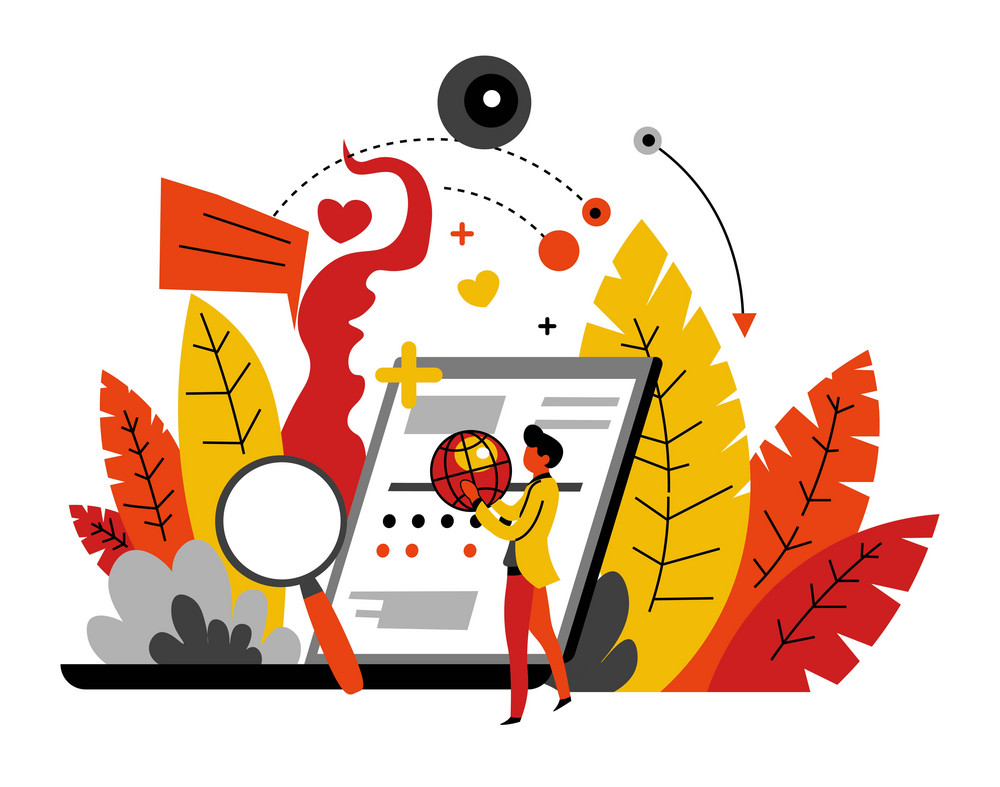
The COVID-19 pandemic has made retailers adapting to home delivery or online models, much of the workforce staying home, people are looking for clear, specific information about where, how, and when to get the things they need. Therefore, you can make use of specific ad copies, ad extensions where applicable to communicate benefits like free delivery, fast delivery, curbside pick-up, porch drop-off, etc.
Negative Keywords
There are a lot of major and minor changes in user queries that are triggering your ads. Because of which you must approach your campaigns in two different ways:
- In a reactive manner where you review search terms and display campaigns for COVID-19 keywords and content in real-time.
- React proactively by predicting which terms will trigger your ads and create negative keyword lists that can be used across all campaigns.
You can exclude keywords such as COVID, Coronavirus, Epidemic, Pandemic, etc if they are not relevant to your line of business.
Reconsider your Marketing Channels
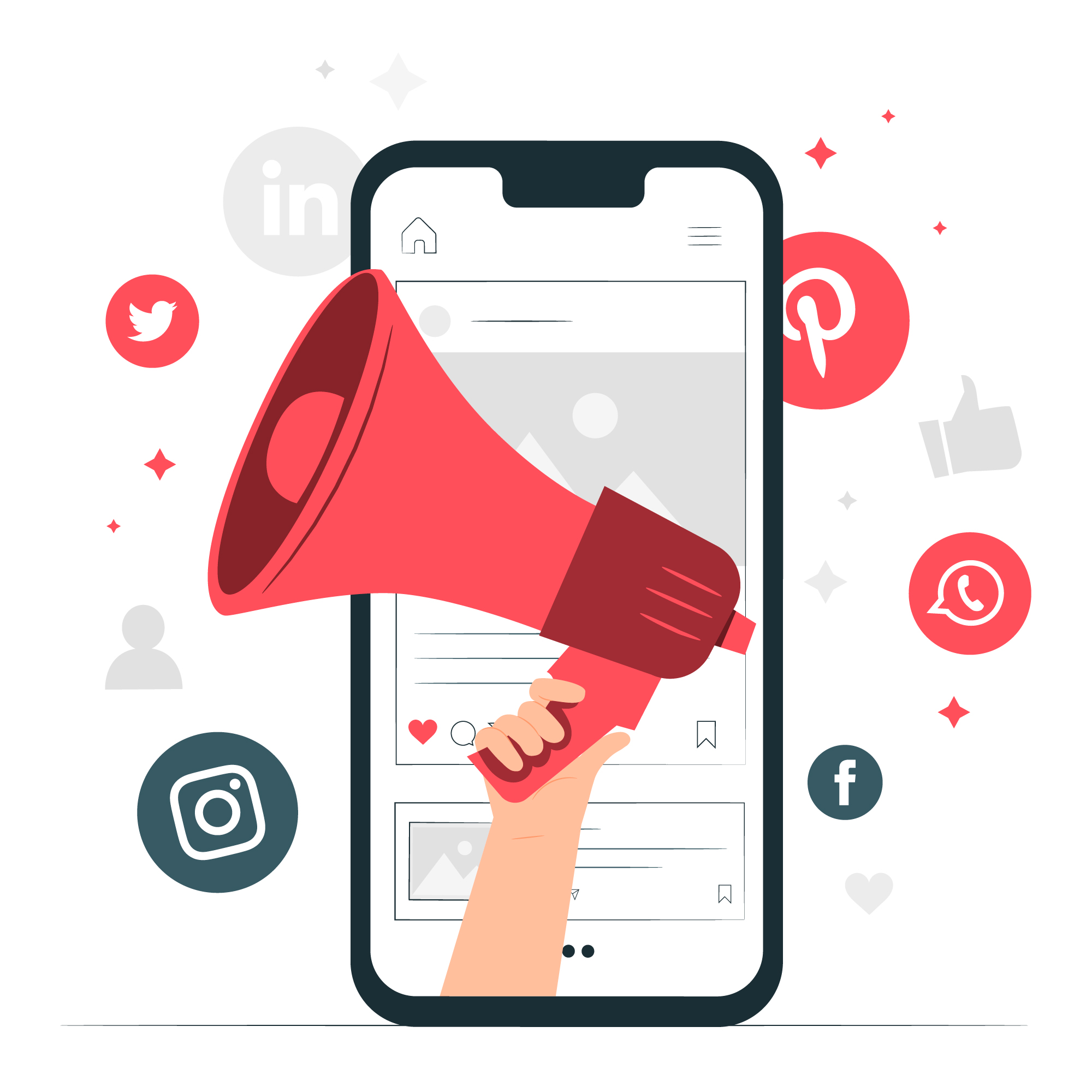
Now that everyone is within the comforts of their home, people are consuming more news-related content, videos, and using online communication tools more than ever. Messaging on Facebook and its apps, Messenger and WhatsApp, have increased by 50% of its usage since the outbreak. Before the pandemic, users spent more time in WhatsApp and live streams, the messenger platform showed a decrease in ad revenue. However, with more people returning to Facebook and Messenger, there’s an opportunity for advertisers to increase their market share. Reaching more people at the top of the funnel with PPC and paid social media ads is an opportunity worth grasping.
Prepare for Normality

The tips discussed above are just quick fixes to ensure your campaigns are not affected negatively during the crisis. At a point in the near future, the restrictions will be lifted, albeit in parts. Consumer behavior will change to what it was and some sense of normality will occur. At that time, you will need to evaluate if things remain the same pre-outbreak if not, you will have to make adjustments to ensure that it is better than what was before. Therefore, be prepared for the future.
We’re all in for change over the next few months – both online and offline. While you’re stuck inside, keep an eye on your PPC accounts and keep your account’s performance healthy. If you require expert support with your PPC campaign during this outbreak, you will need a PPC agency you can trust.
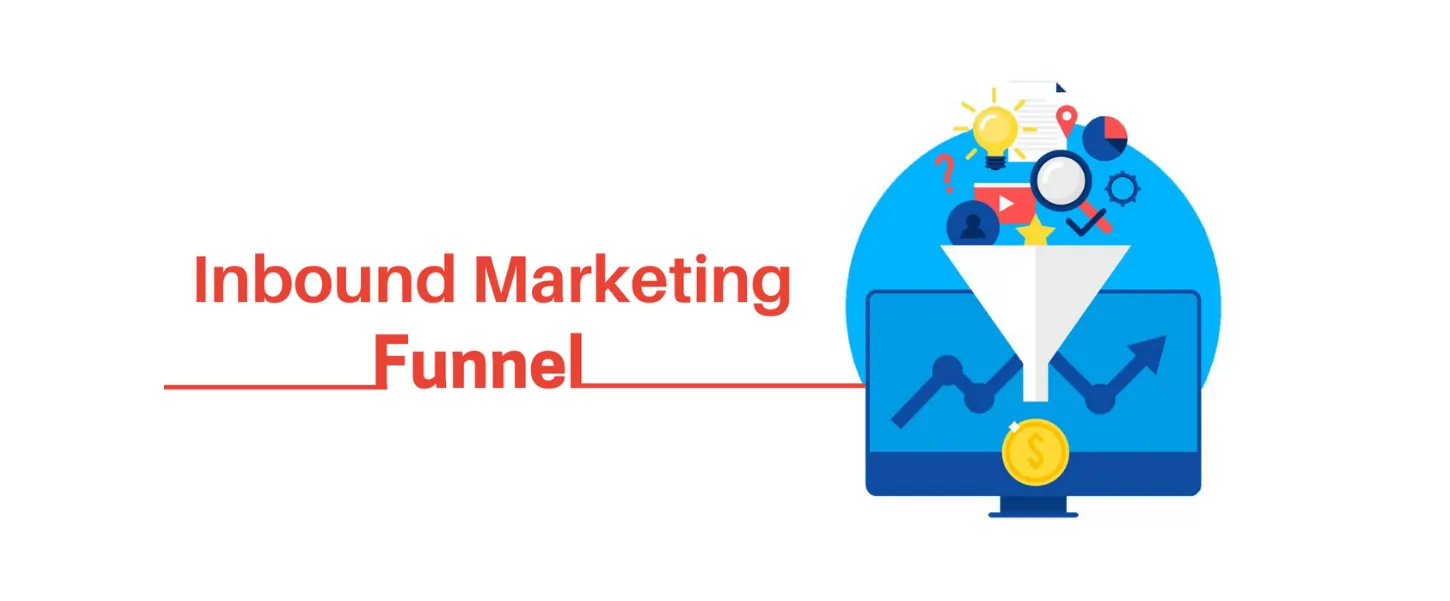
What To Know About Inbound Marketing Funnel? – Infographics
Most business professionals should be familiar with the concept of the funnel model. A digital marketing related counterpart of the same would be the Inbound Marketing Funnel. This model is a great way to represent the path of a prospect, to a lead, and finally to a customer, all the while tracking the entire sales process. It tells you what exactly the marketing message is supposed to be, and when and where to market those. The inbound strategy built on the funnel model works well as it equally benefits both the marketers as well as the clients. You can see the funnel-shaped model given below, which is broken up into three parts: To-Fu(Top of the Funnel), Mo-Fu(Middle of the Funnel), and Bo-Fu(Bottom of the Funnel).
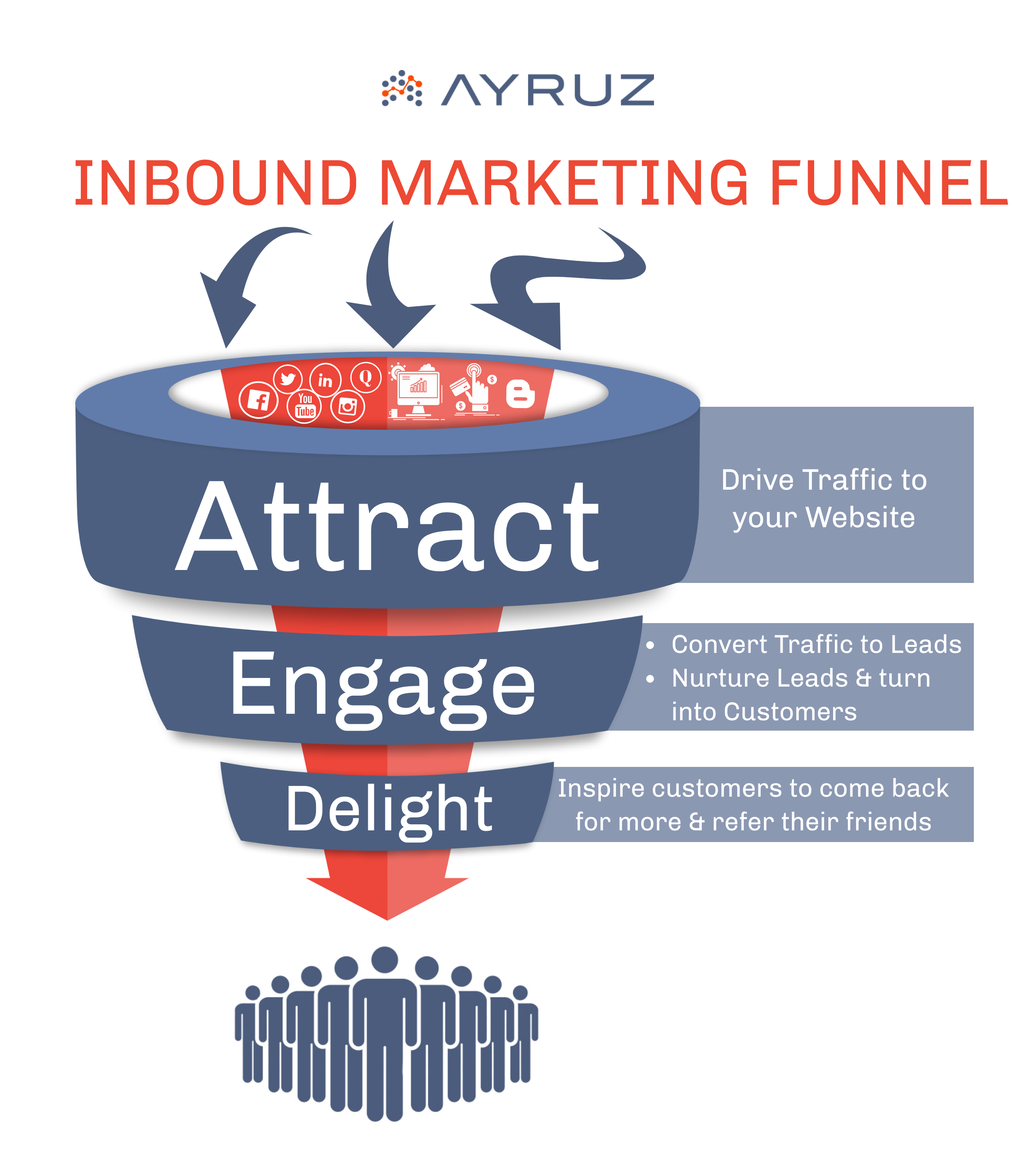
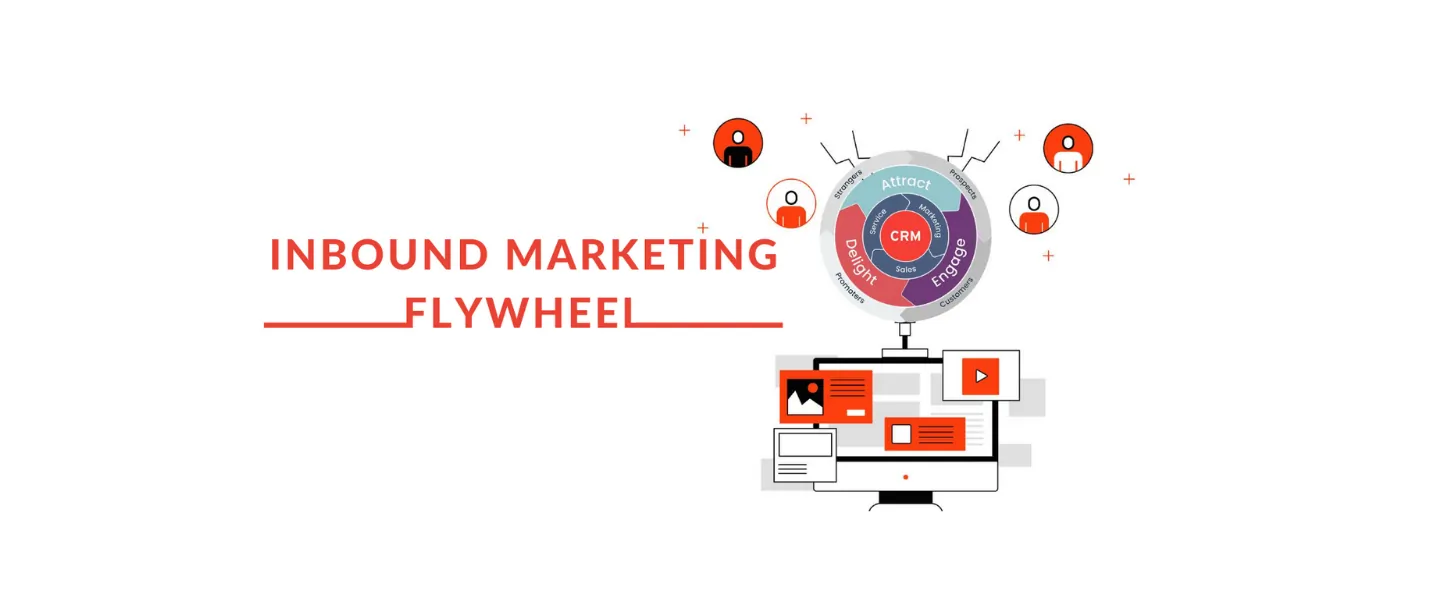
Learn More About Inbound Marketing Flywheel – Infographics
Inbound Methodology
The traditional marketing method for reaching and acquiring new customers is no longer as effective as it used to be. New concepts and strategies around the marketing field were being experimented all over the world, all the time. One such concept called Inbound Marketing was founded in 2005 by Brian Halligan, who is the co-founder and CEO of HubSpot.
The inbound methodology is the process of converting visitors into customers and promoters of your business. Inbound marketing methods have been used since the digital age for building a strong presence on the internet and for business growth. It focuses on creating quality content to attract leads to the products or services you offer. Traditionally the inbound marketing funnel has been the primary model. However, another method called inbound marketing flywheel model has proven to be more effective than later. Let’s see what a flywheel marketing method is.
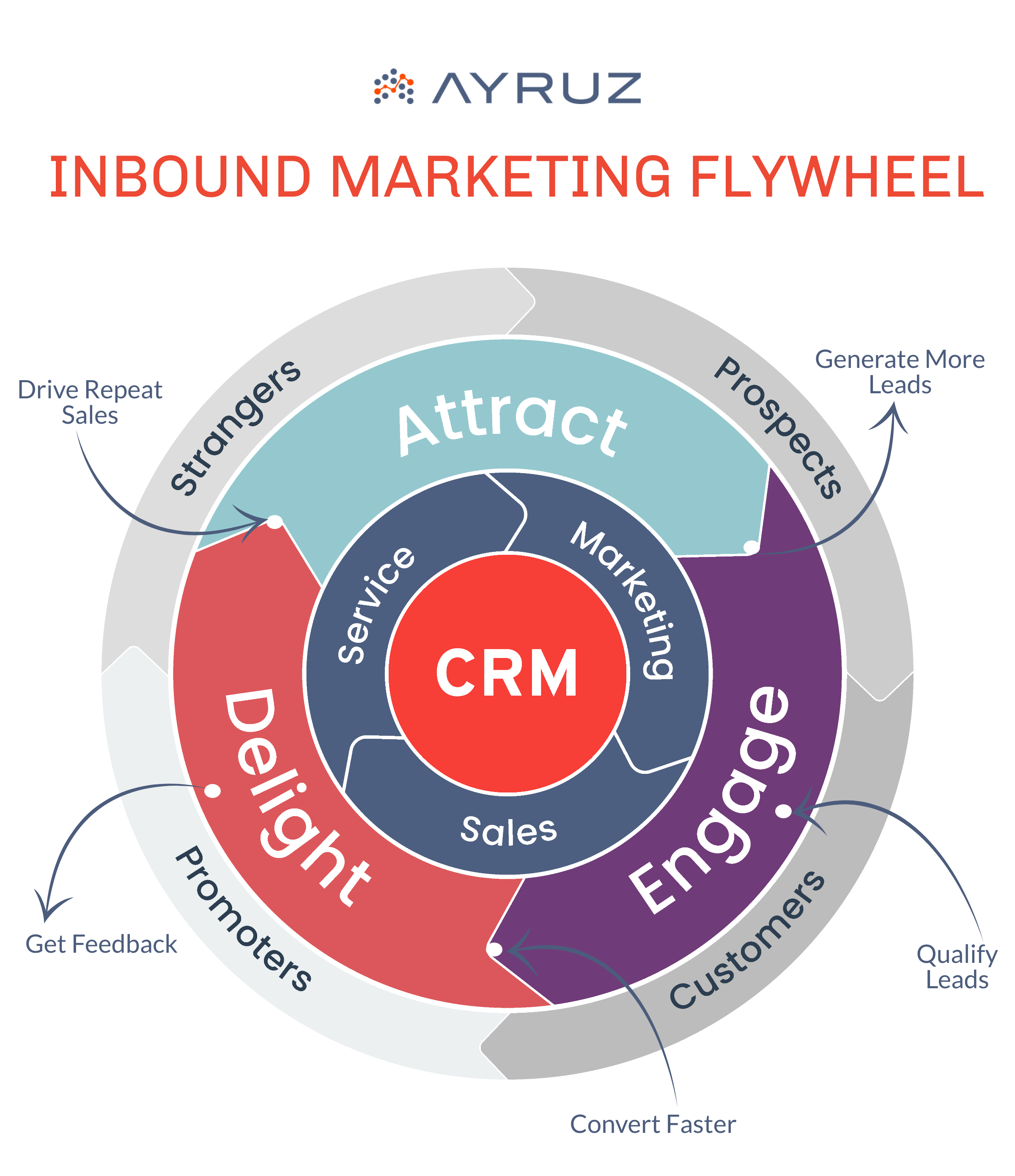
Inbound Marketing Flywheel
The flywheel ideology is similar to an incredible energy-efficient machine that stores rotational energy and increases a machine’s momentum. The more energy you feed to it, the faster it spins-provided you remove the friction points that keep it from spinning. The amount of energy it conserves depends on how fast it spins, the amount of friction, and its size.
From a business perspective, the rotation of a flywheel represents the growth of your business. Just like the flywheel, it is remarkable at storing and releasing energy. The customer base is the center of the wheel. The fuel for its work can either be in the form of customers who become your regular clients or bring new visitors by promoting your product in their network. Inbound businesses that use the flywheel model builds trust, credibility, and momentum among their customers.
In a typical flywheel model, the entire business strategy is made to revolve around the customers and their experience of interaction with the services you offer. So instead of putting customers at the end of a deal, think about how customers can make your business grow.
How do Inbound Flywheel Marketing works?
The inbound flywheel marketing method is divided into three stages:
1. Attract
The goal of this stage is to attract leads to your business or the services you offer. Leads are the ‘visitors’ who come across your website or advertisements. They might not have any intention to become a customer, yet would have the means to afford your services. You can establish a point of contact with the leads utilizing the features that include paid advertisements, content marketing, social media marketing, and search engine optimization. The essential purpose at the end of this phase is to earn people’s attention and not force it.
2. Engage
Once you attract the leads, communicate with them by various means to turn the leads into prospects. Prospects are defined as potential customers in business terms. In this phase, you focus on building relationships with the leads who have had initial contact with your brand, to introduce your products or services through personalized methods. Some of these include personalized emails, lead enrichment, multichannel communication(chats, messaging, etc.).
3. Delight
The delighted customers who are satisfied by the product you sell and the customer service become regular customers or become promoters of the products/services they love or both. Just like a rotating flywheel, the chance of customers bringing in new leads or prospects increases with the level of their satisfaction with your services. Thus starts the next cycle of newly referred visitors. You attract new leads, engage them with your services, and focus on their satisfaction to repeat the cycle.
Finding The Friction Points
You must eliminate all the possible opposing forces that may slow down your business’s progress with the customers. In order to do so, you need to identify which area of your service requires repair and what kind of strategy you can apply to make the process smooth again. In a customer-oriented process on which the flywheel marketing operates, the priority should always revolve around customer satisfaction. The less the friction is, the more the flywheel will rotate, and more energy will be conserved for use.
Why use the Flywheel Method?
The Flywheel method’s major advantage is that the businesses adopting this method will have natural and organic growth, which results in loyal customers who will stick with them for the long term. The aspect of getting a beneficial outcome will be as slow as it can be. However, the foundation of a brand laid on a flywheel ideology will be solid. It will help you gain advocates for your company that can boost your growth. Rather than getting the sales done alone, the inbound flywheel marketing will help you focus on the overall progress and point out the areas in which your business needs more work.
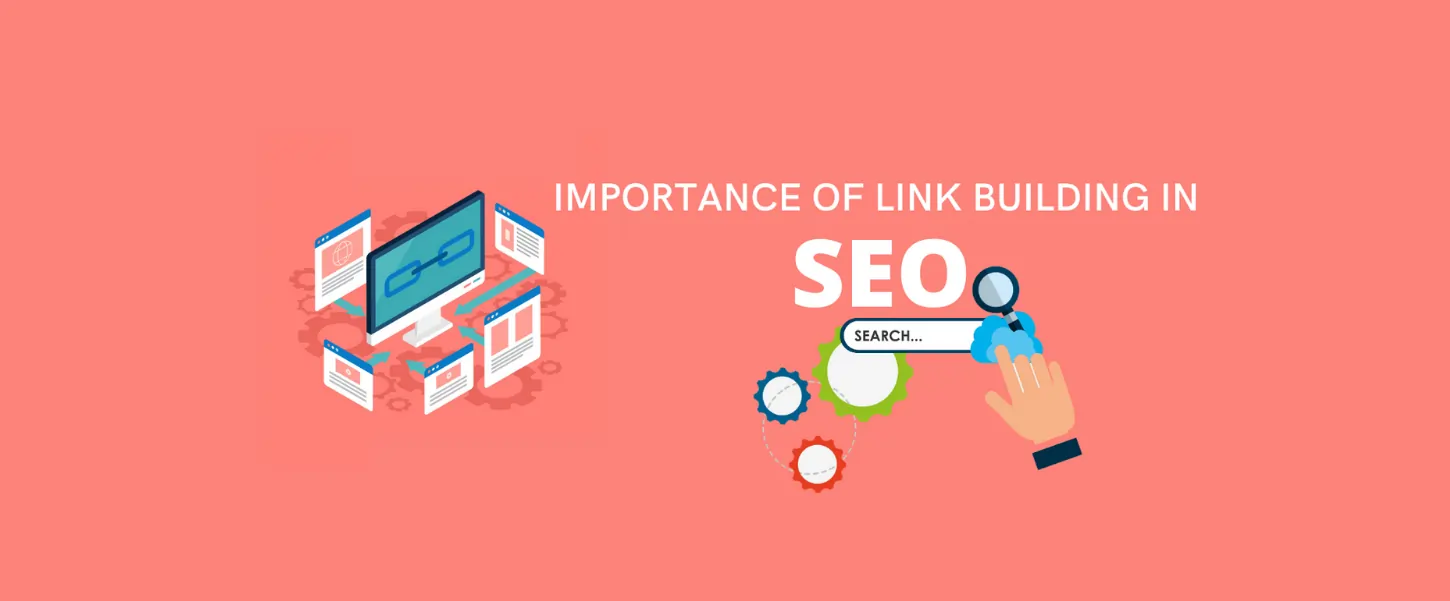
Importance Of Link Building In SEO
Have you ever wondered why your page is not getting the traffic it deserves?
You may have created quality content. However, that is not enough to outrank the rest of the websites and get to the top of the search results page. To get ranked above in the search results page, you should also implement a few digital marketing strategies that would highlight your content on the webpage and help reach out to the right audience at the right time. Building links is one of the most productive methods in search engine optimization, that not only improves your page ranking but also drives organic traffic to your website.
What is Link Building?
Link building is a strategy that gets different webpages to link each other by acquiring hyperlinks from other websites to your own. Hyperlinks are primarily used to navigate between pages and websites on the internet. Search engines use links (robots) to crawl through the websites to acquire new and updated content and store them so that it can give those results when the user requires a solution for their query. In that case, they will crawl the links between the individual pages on your website and will crawl the links between entire websites as well. Having the right type of links on your website is one of the best ways to improve your search ranking, raise traffic, establish the authority of your site, and improve the overall customer experience.
In the beginning, the link building strategies were simple to follow. The anchor texts contained a lot of keywords back then, and they helped in determining the rank of a page. However, this led to the making of several websites that in no way provided any valuable or useful content. The importance that was given to the number of keywords in the anchor text became invalid since then. Google’s only goal became the quality of the content presented. Then soon after, the same became the goal of the marketers as well.
How does Link building work?
It is essential to know how a link is created to understand the link building process. A link can be divided into four parts.
1. The start of the link: It is called an anchor tag. This part is recognized by ‘a’ given at the beginning. It opens the tag and indicates the search engine that a link to some other web page is about to follow.
2. Link referral location:- This section of the link is recognized by ‘href’ followed by a text inside a quotation mark that shows where the URL is leading. If you see a hashtag ’#’ instead of a URL, then clicking on the link will take you to another part of the same page.
3. Visible text of the link:- This section consists of a small piece of the text that you will see on the page, on which you need to click if you want to open the link. It is formatted in such a way that it stands out from the rest of the link so that you can quickly spot it. The text will be colored in blue, with blue underlining to indicate that it is a clickable link.
4. Closure of the link:- This part indicates the search engine that the link has ended.
Links and Search Engines
When building links, the focus is mainly on the quality and significance of the links. The search engine has three primary functions.
- Crawl:- it is the discovery process in which search engines send out a team of robots (known as crawlers) to find new and updated content.
- Index:- Store and organize the contents found during the crawling process, and then display it as a result of relevant queries.
- Rank:- Provide the pieces of content that will best answer a searcher’s query.
Once search engines have crawled pages on the web, they can extract the content of those pages and add them to their indexes. In this way, they can decide if a page justifies being ranked well for relevant keywords. While regarding the websites, the number of links of relevant and quality external websites pointing to that page is as equally important as the main content of the page. The more high-quality websites that link to you, the more likely you are to rank well in search results.
The three major types of link building to boost your website’s search rankings are:
1. Inbound links:- An inbound link is a link of another website to a page on your website. A webpage with a good number of inbound links from authorized sites is considered to be trustworthy, as those sites are casting a vote of confidence by linking their pages to that website.
2. Outbound links:- The links to external sites from your website are called outbound links. They direct away from your website, sending traffic externally to another. Creating outbound links to legitimate sites will not only provide value to your visitors, but it will boost the authority of your site as well.
3. Internal links:- Internal links are the links that go from one page on a domain to another page on the same domain. They help the site visitors find similar content on your website, which will hold them on your site for a longer time.
In addition to this, there is one more type of link called the reciprocal link. A reciprocal link is an agreement between two websites to provide a hyperlink within their website to each other’s site. Primarily this is done to provide readers with quick access to the associated sites or to show a partnership between two sites.
Benefits of Link Building
Link building is vital for effective search engine optimization. The number of inbound links from quality websites is an influential factor for determining your rank in the Google search results page.
- To get more visibility of your blog in search results.
- To receive traffic from other websites linked to you.
- High-quality incoming links indicate that your site will be admired as a valuable resource.
- It has longer longevity, and hence it is cost-effective.
- Link building is an excellent way of presenting your brand webpage, to come across as a leader in your industry.
In a period where the extent of competition in the digital platform is at the highest, it’s crucial to evaluate and update your marketing operations and SEO strategies constantly. Contact us to get a head start on your brand marketing strategies with the latest tools and technologies.
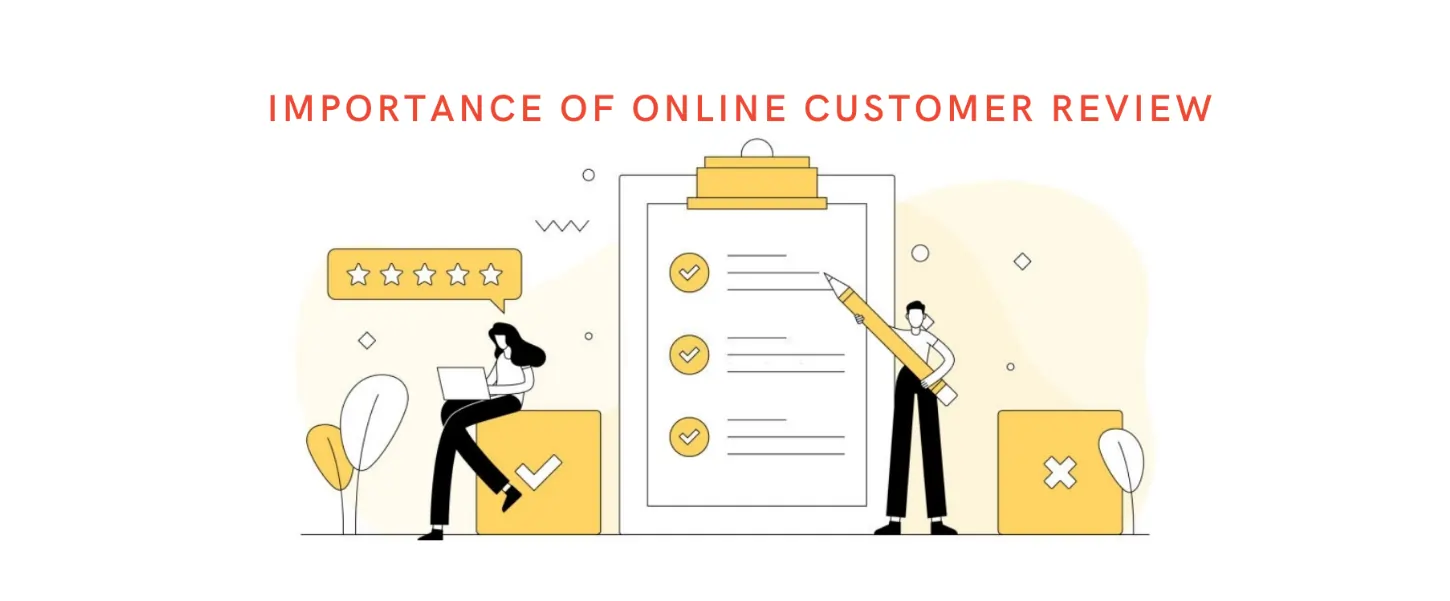
Why Are Reviews Important? – Infographics
Whether in a retail store or online, how do you ultimately make your purchase decision? Do you lean towards a brand you already know and trust? Or do you choose the product with the lowest price? Along with these factors, one of the largest influencers that directly impact consumer behavior is Online Reviews.
Reviews not only have the power to influence consumer decisions but also strengthen a company’s credibility. Online reviews can effortlessly gain the trust of customers and encourage people to interact with the company, which ultimately leads to improved profits for businesses. Statistics show that 72% of people will only interact with brands that have positive reviews to determine what products or services to purchase. That means, having a positive online presence with good reviews will give your brand several key advantages.
Understanding why you need online reviews will help you optimize your customer experience to create a positive online footprint. Let’s see why your consumers’ published experiences with your brand are vital through these infographics given below.
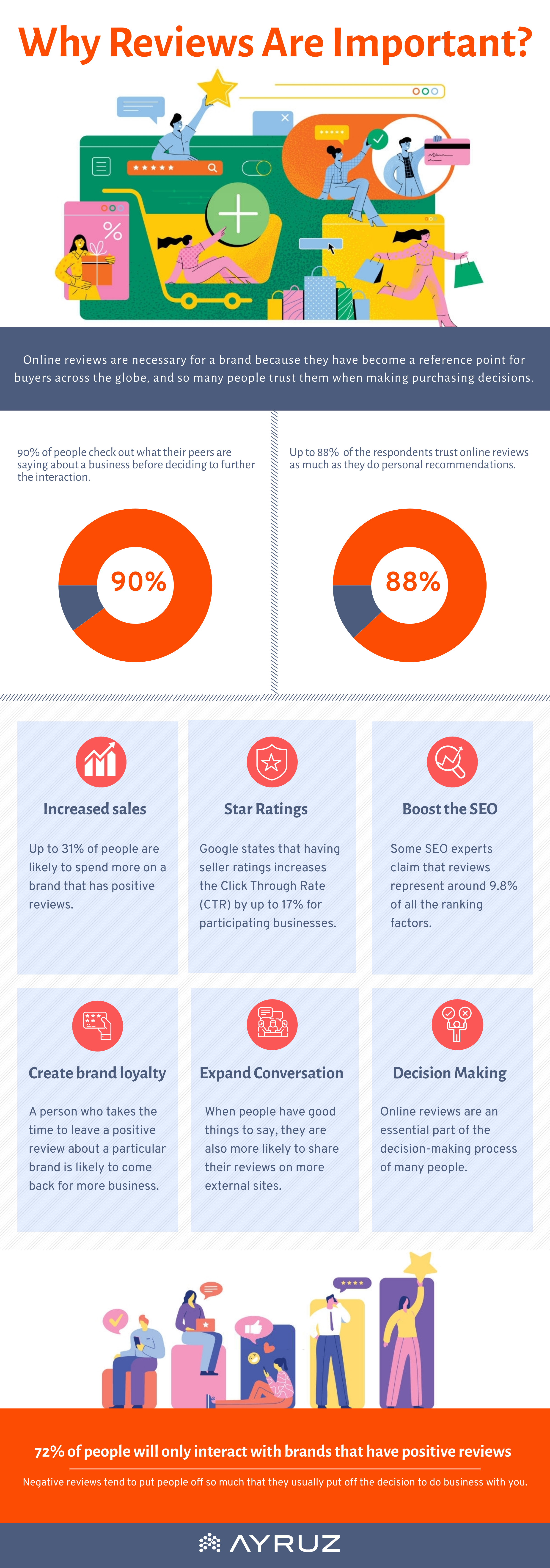
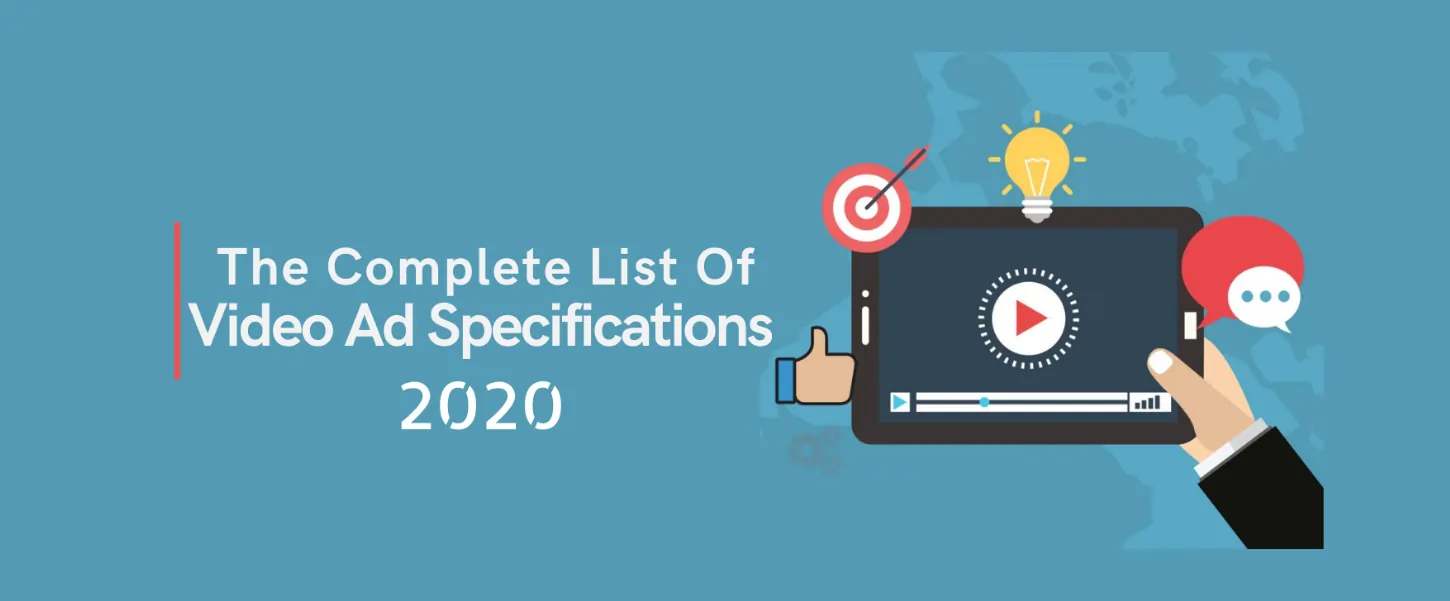
The Complete List Of Video Ad Specifications – 2020
Are you struggling to focus on different social media video size specifications? We may help you find the necessary video Ad specifications, all under one roof.
Video ads are a proven successful social media marketing strategy. According to a study, nearly half of all social media ads are spending their money on video. That is because it is easy to attract the audience to an eye-catching video than a single image to communicate everything within a brand.
Every platform holds different specifications for their Ads, and they are updating it every time. As all the social media platforms release new video ad formats and update old ones, it can be laborious to keep up with the changing trends altogether. So, we’ve created a list of social media video Ads specifications and formats to help you modify your content for a better view. In this article, we’ll share video Ad specifications for YouTube, Facebook, Instagram, Twitter, and LinkedIn.
YouTube Video Ads Specifications
Over 250 million hours of video are seen by viewers on YouTube every day, while 500 hours worth of videos is uploaded each minute. YouTube offers seven ad formats, each designed to help advertisers perform different intentions.
Display Ads
There are two types of display ads. The first one will be the regular display ads. It can be seen at the right of the featured video and can also feature above the video suggestions list. It appears below the video player if it is playing on larger players. And these ad sizes are either 300×250 or 300×60.
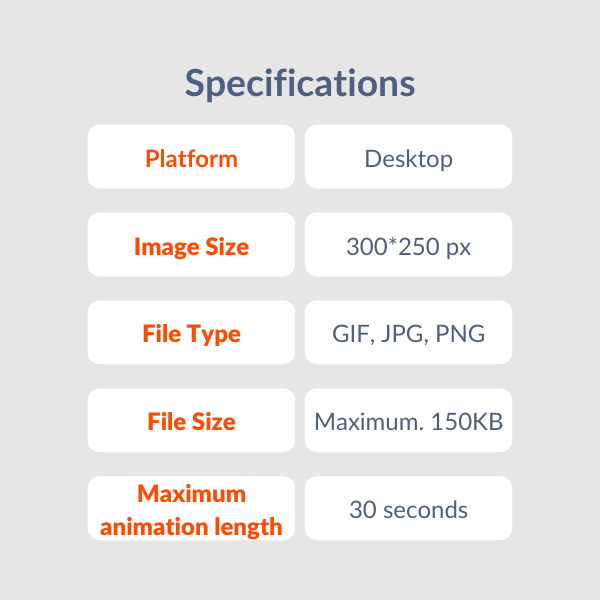
Overlay Ads
Overlay ads will appear directly over the video while it is playing. They take up 20% of the video screen size. Overlay ads are designed to attract desktop users only due to the amount of screen real property.
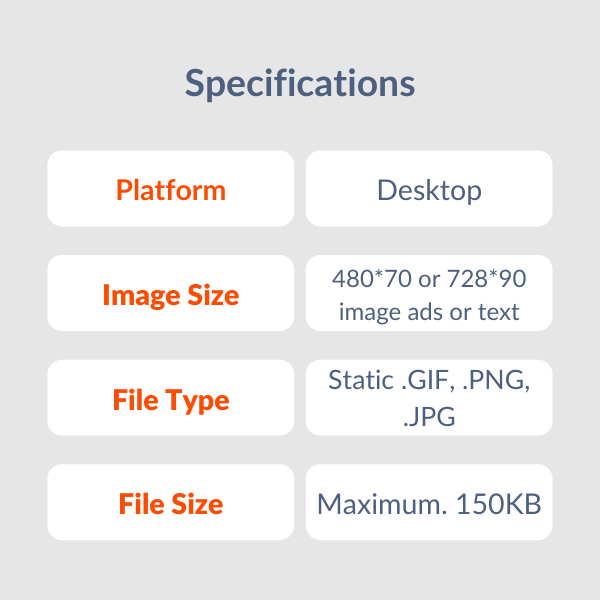
Skippable Video Ads
Skippable video ads play before the main video begins. This type of ad allows viewers to skip ads after 5 seconds if they choose. Depending on how YouTube servers up content, is possible for viewers to see more than one skippable ad. Providing viewers with the option to skip your ad can also lead to viewers experiencing a combination of skippable and bumper ads play back-to-back. They provide a better user experience for viewers and provide you with the opportunity to put up lengthy ads.
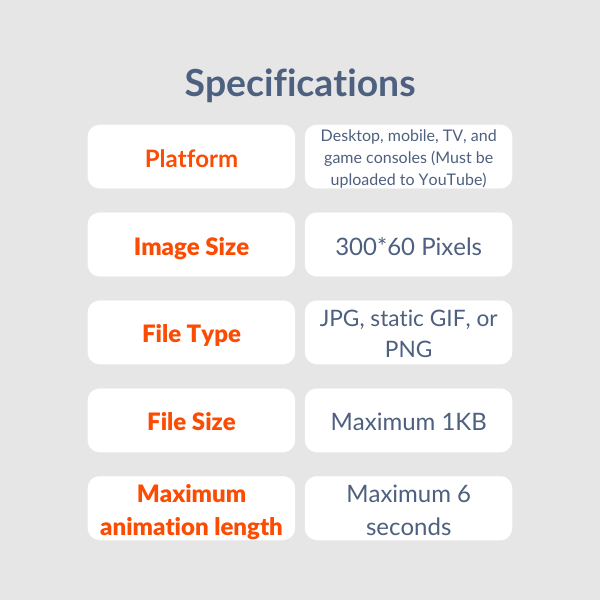
YouTube Companion Banner Ad Specs
YouTube’s companion ads are small, where clickable static images are displayed below a video or in the right-hand margin of your screen. Given the nature and placement of this type of ad, they give a specific appeal to desktop users. A companion banner provides continued brand presence after a video ends, and the viewer can click on it at any time.
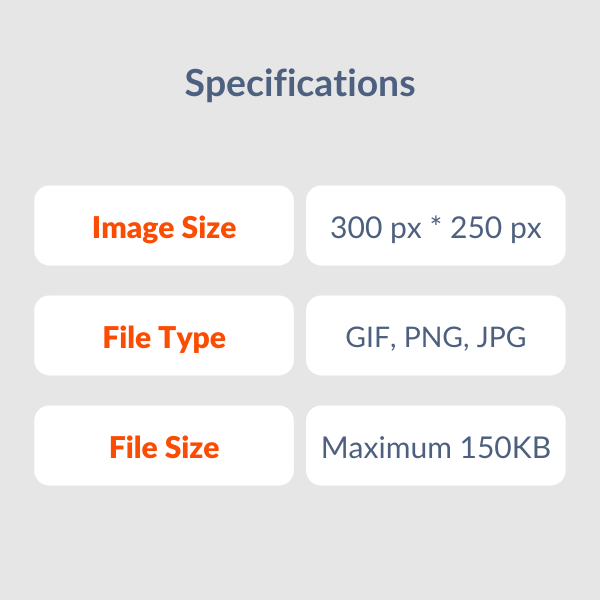
Non-Skippable Video Ads
Non-skippable video ads are those ads where the viewers do not have the option to skip the ad. So basically, they have to watch the entire ad before going into the video they chose to watch. These ads can appear before, during, or after the main video. Depending on the region you’re targeting, they can also play for 15 or 20 seconds.
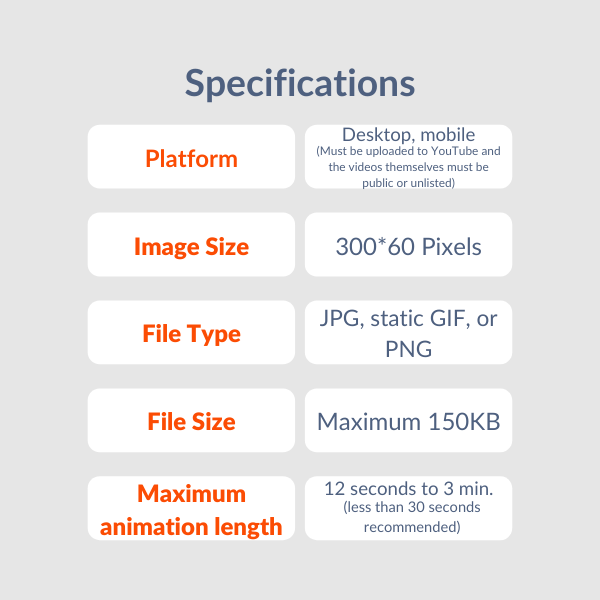
Bumper Ads
Bumper ads are non-skippable video ads that play for up to 6 seconds before going to the main video. Turning on this option may show viewers a combination of skippable and bumper ads play back to back.
The short length of bumper ads makes them uniquely effective at keeping attention because a countdown timer shows viewers how long the ad will last. Recently, Google found that viewers are far more likely to recall the bumper ads compared to the other types.
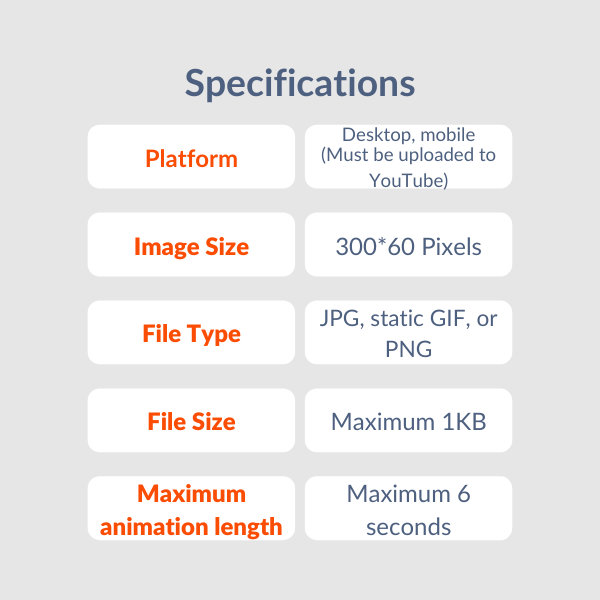
Sponsored Cards
Sponsored cards display content that may be relevant to your video, such as products featured in the video.
Viewers will see a teaser for the card for a few seconds. They can also click the icon in the top right corner of the video to browse that card. The sponsored cards are mobile-friendly. So they’ll reach the growing legions of viewers who watch YouTube on mobile devices.
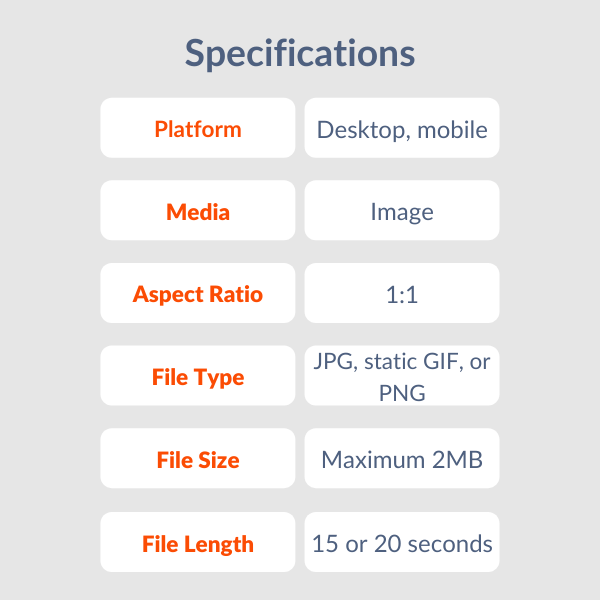
Facebook Video Ad Specifications
When it comes to Facebook video Ads, there is one key recommendation to its advertisers that is it should design for mobile-first. Facebook recommends uploading a video with square (1:1) or vertical (4:5, 2:3, and 9:16) aspect ratios, to maximize compatibility on both desktop and mobile screens. The platform also recommends 15 seconds or less video size and designing videos that work with and without sound (by enabling captions).
Facebook Feed Videos
The video feeds placement lets advertisers show video ads between organic videos in video-only environments. For all video ad types, Facebook recommends uploading the “highest resolution source video available without letter or pillar boxing.” Facebook provides an exhaustive list of aspect ratios and features available for each ad type.
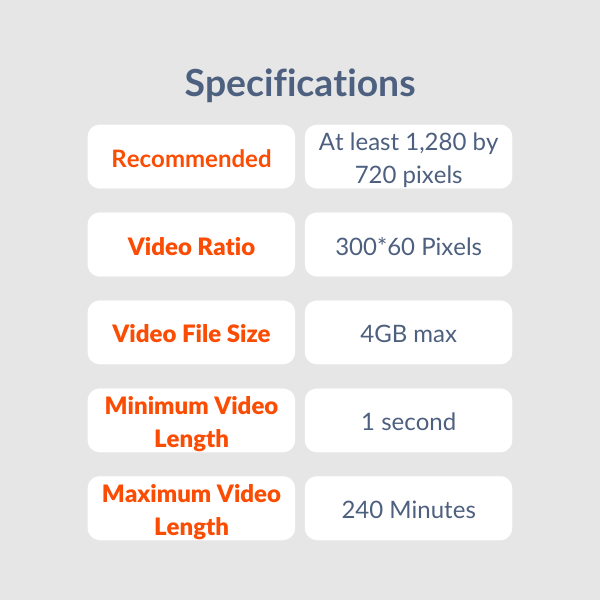
Facebook Instant Article Videos
Instant Article is a mobile-optimized format that enables publishers to distribute fast-loading interactive articles to Facebook’s app. Certified publishers may choose to place ads within their instant articles. Selecting an instant article as the placement for your ad will allow it to appear when people from your audience view these articles.
Source: Facebook
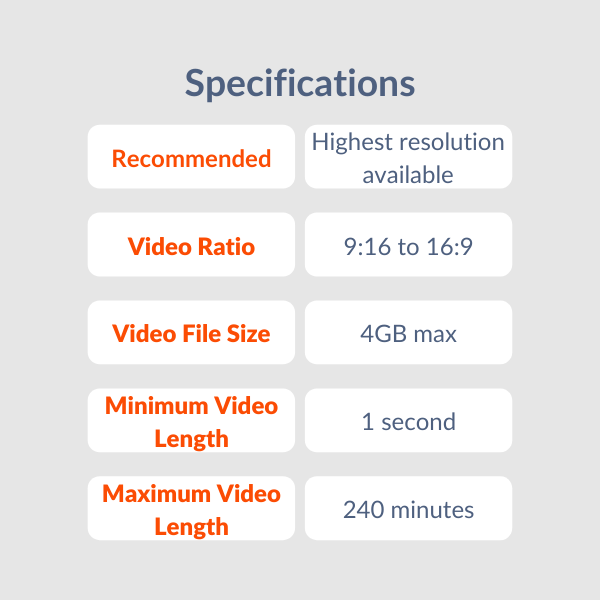
Facebook In-Stream Videos
Facebook In-stream videos allow advertisers to deliver 5-120 second video ads to people watching videos on Facebook from familiar publishers and digital-first creators that tailor their content to Facebook audiences. The ads can also appear in Facebook Live streams from a chosen group of approved gaming, entertainment, and sports partners.
Source: Facebook
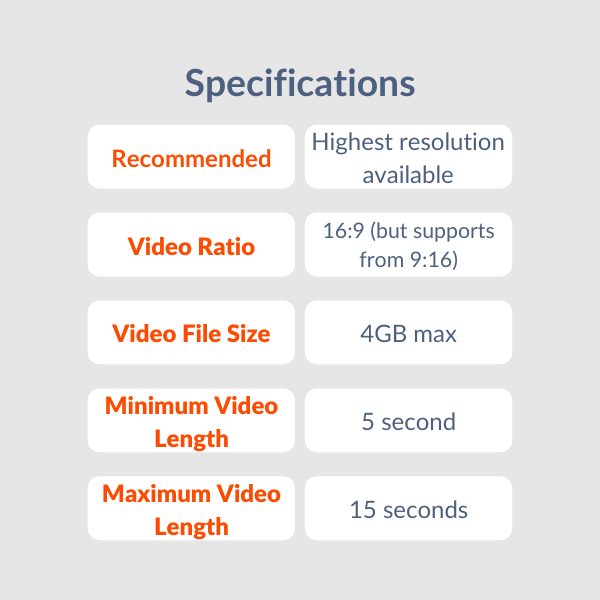
Note: If your video thumbnail consists of more than 20% text, you might see reduced delivery in the video.
Facebook Marketplace Video Ads
When you create a Facebook ad in Ads Manager, you can have your ad appear in the Marketplace to reach more people. Instead of buying and selling through user-created Facebook groups, anyone could list a product on the Marketplace and connect directly with potential customers in their area. The more people who follow your business profile on Facebook, the more your items will appear in people’s news feeds. Ads you create will also show up in Facebook Marketplace.
Source: Facebook
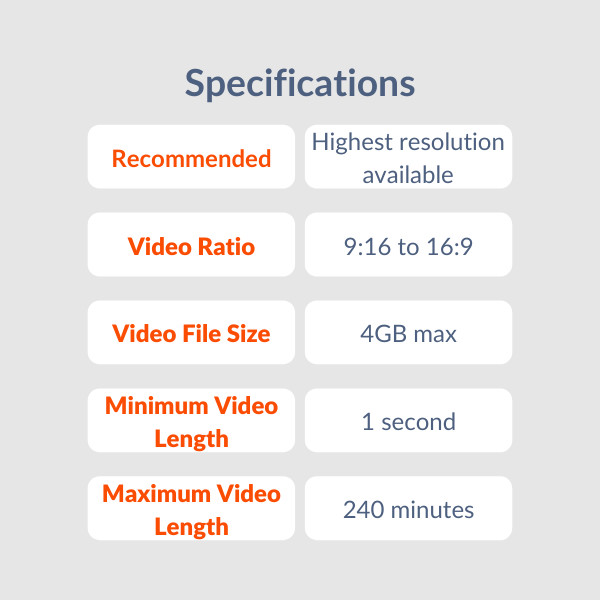
Note: If your video thumbnail consists of more than 20% text, you might see reduced delivery in the video. Also, if you have a vertical video with an aspect ratio taller than 2:3, it may be cropped to 2:3.
Facebook Stories Ads
Stories are where people share and discover content they care about in fast and fun ways. More than 300 million people use Facebook Stories and Messenger Stories every day. Now you can include Facebook Stories as an additional placement to News Feed ad campaigns, delivering your message in an immersive environment. Facebook Stories ads support every objective necessary for marketing, including reach, brand awareness, video views, app install, conversion, traffic, and lead generation.
Source: Facebook
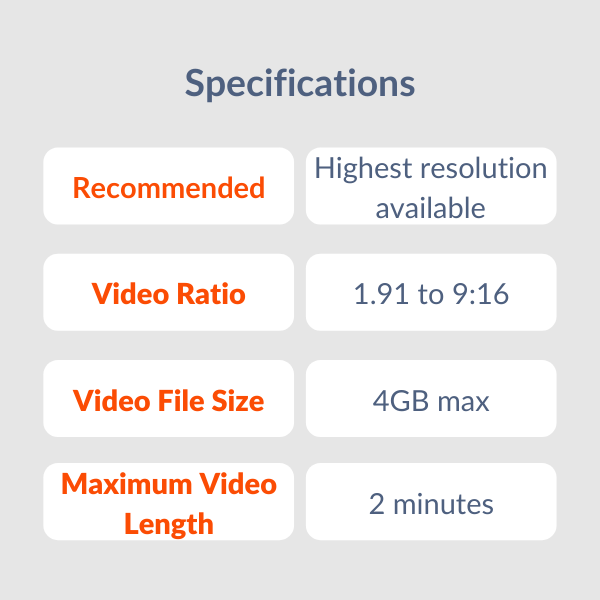
Note: If your video thumbnail consists of more than 20% text, you might see reduced delivery in the video.
Facebook Video Feeds
Source: Facebook
Video ads capture the attention of your audience better than any other type of ad. Facebook video feeds are different from in-stream videos and Facebook videos you see on your newsfeed. When a user clicks on a video in their feed, that video will open up in a player with other video feeds below. These ads appear in those video feeds.


Note: If your video thumbnail consists of more than 20% text, you might see reduced delivery in the video.
Instagram Video Ad Specifications
Instagram Feed ads are mobile-only placements that look like standard Instagram posts. They drive more qualified traffic and are a cost-effective way of generating brand awareness and getting click-throughs. There are three different formats of Instagram videos, square, vertical, and landscape. Instagram feeds are a large source of creating audience attention.
Instagram Feed Video Specifications
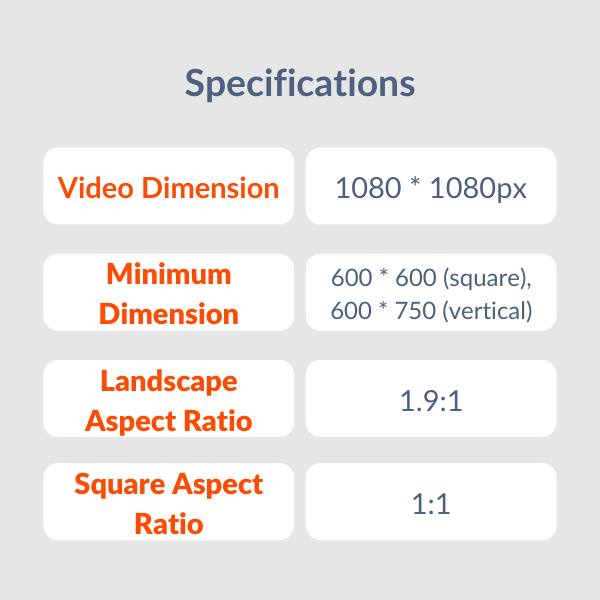
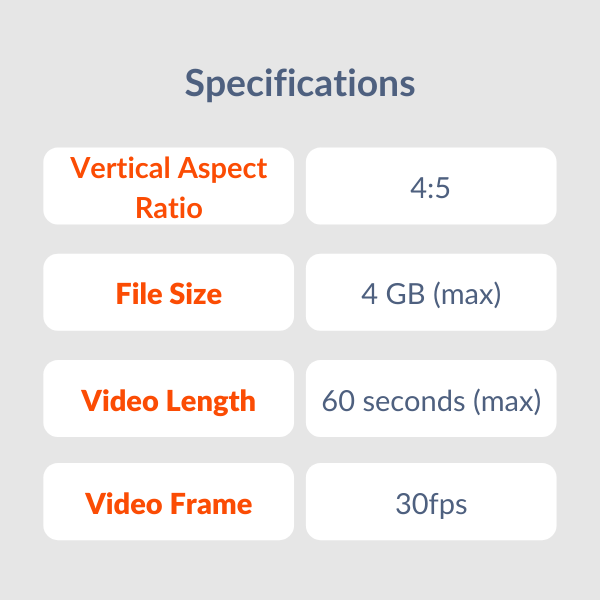
Carousel Video Ads
It is much similar to the Facebook carousel ads. Carousel ads allow the advertisers to showcase multiple photos with a call-to-action button in a single advert unit. With the addition of video, advertisers can share up to five pieces of content for a more loaded storytelling experience.
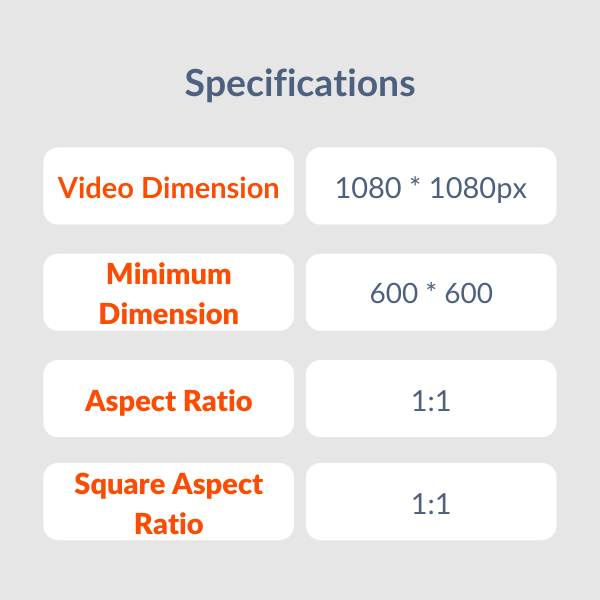
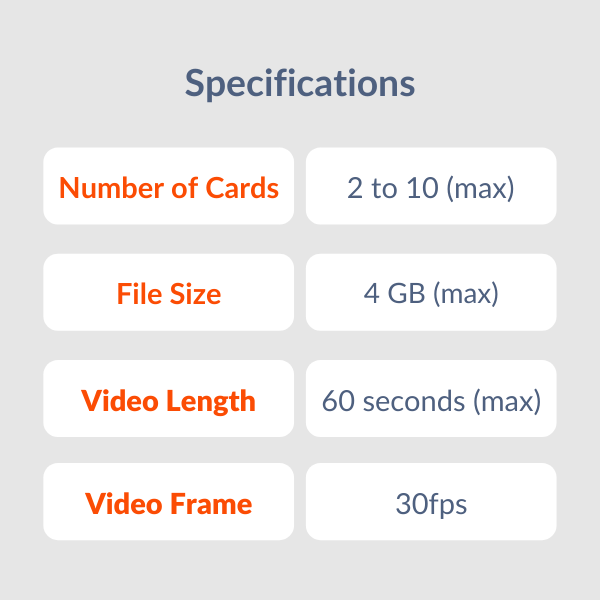
Instagram Stories Ads
With full-screen, vertical format, you can share photos and videos of your businesses to attract the audience to your content. With the ability to target your ads by reach, video views, traffic, conversions, app installs, and brand awareness, you can drive business results at the same time. However, note that the Instagram ad story disappears every 24 hours.
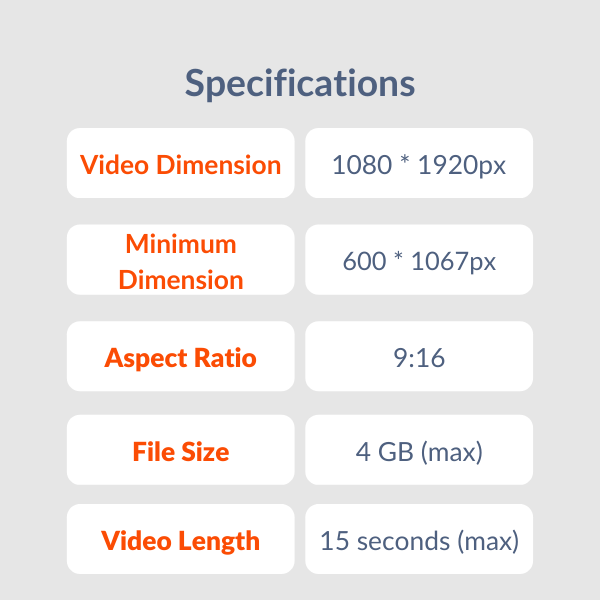
Twitter Video Ad Specifications
Twitter is the largest hub of social media platforms, containing over 2 billion active profiles. It is a popular space to share and interact with people, and therefore, is the best platform for marketers to advertise. It is the perfect way to maximize your ad videos’ views, as the videos will auto-play within home timelines, encouraging interaction by tap or click.
Twitter In-Feed Video
There are two video formats for the Twitter feed, landscape, and portrait that are used to upload a video on Twitter directly. There are no particular specifications for Twitter feeds.
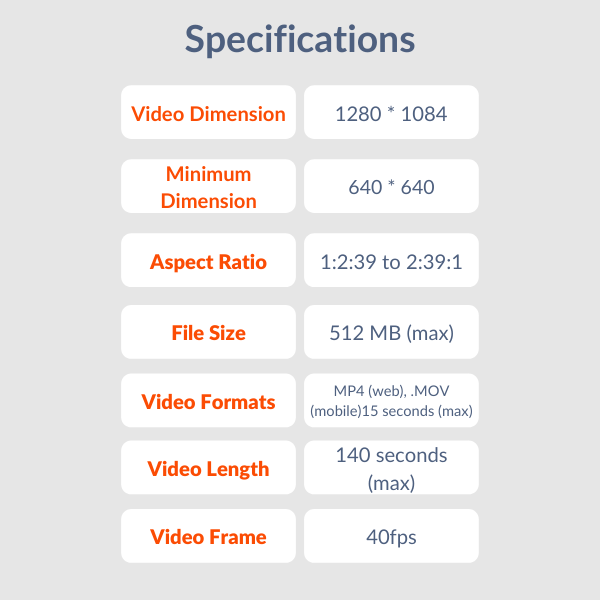
LinkedIn Video Ad Specifications
LinkedIn is the perfect social media platform for B2B online advertising campaigns. On a social media platform where there’s more business content, the video content stands out more, especially on LinkedIn.
Source: LinkedIn
LinkedIn Shared Video
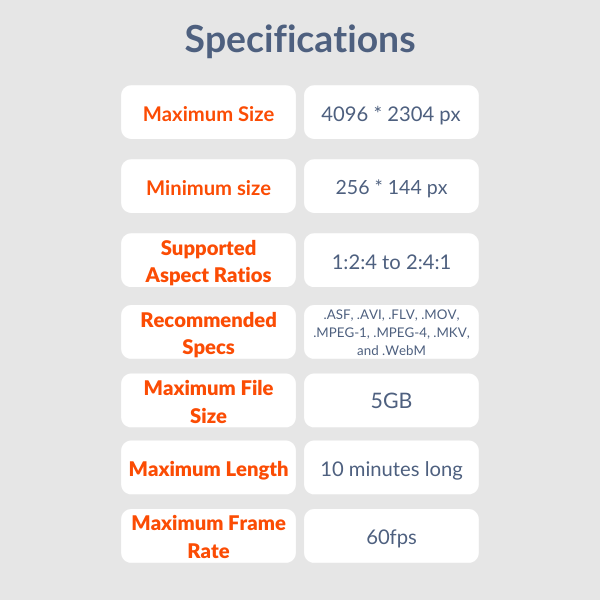
LinkedIn Video Ads
